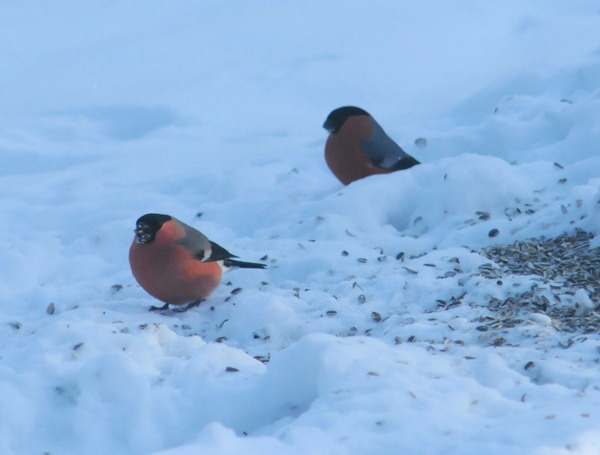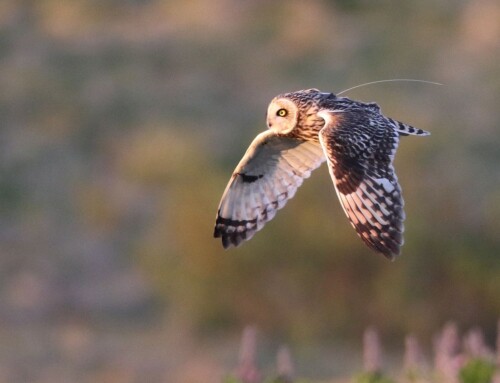LINKED PAPER
Increasing winter temperatures explain body size decrease in wintering bird populations of Northern Europe—But response patterns vary along the spatioclimatic gradient. Bosco, L., Otterbeck, A., Fransson, T., Lindén, A., Piha, M., & Lehikoinen, A. 2023. Global Ecology and Biogeography. DOI: 10.1111/geb.13754. VIEW
In 1847 the German biologist Carl Bergmann attempted to explain why populations of endothermic species are larger in colder environments but smaller in warmer regions – driven by the endeavor of explaining the link between species’ morphology and physiology. The idea behind this rule is an optimized surface area to volume ratio, which is lower for larger animals so that they radiate less body heat and thus stay warmer in cold climates (Bergmann 1847). Now, more than 150 years later, ecologists apply Bergmann’s rule to unravel how species’ morphology adapts in response to changing climates. Warming temperatures, more frequent droughts and floodings, or earlier onsets of spring are all consequences of anthropogenic climate change and force species to either adapt locally, move, or perish. While poleward shifts of species’ distributions in response to warming temperatures has been a relatively well known and researched phenomena, morphological changes as a consequence of climate change have not been researched as much. Recent studies do show that species body size has been declining and that this is quite likely linked to warming temperatures. Yet, we lacked an understanding of how such changes vary geographically, especially along the South-North gradient, and across several species. To answer such a question, we need good quality long-term and large-scale data of species body size measurements with site-specific information which can be linked to local climatic conditions – a rather long list of attributes to be fulfilled. Amazingly, in Finland and Sweden, bird ringers have been visiting winter bird feeding stations for over 50 years where they regularly ring birds and take morphological measurements.

Figure 1. In Finland and Sweden overwintering birds have been ringed for over 50 years, mostly at feeding stations – although not all of them are made of snowmen like this one offering food to yellowhammers © Aleksi Lehikoinen
Another advantage of using this data is the season: winter ecology is often overlooked, while temperature warming is happening at faster rates during winter, especially at high latitudes. In addition, and most importantly, including bird species which were ringed during the winter months in Finland and Sweden means that those species, obviously, are resident or short distance migrants. This is important in the context of body size change because long-distance migrants may undergo opposing selection pressure for longer wings and optimised body size in relation to ambient temperature. Being privileged to use such a fantastic dataset, we attempted to unravel the question whether birds have become smaller in response to climate warming and how this varies spatially along a 1500 kilometer climatic gradient from the southern tip of Sweden to the northernmost part of Finnish Lapland across 24 bird species.

Figure 2. Bullfinches, together with great tits and bluetits, were among the most commonly ringed and measured species in our long-term dataset from Finland and Sweden with more than 24000 measurements since the 1970s © Aleksi Lehikoinen
Across all species the mean wing length decreased by 0.4% since the 1970s, while the average change in body mass was stronger with a decrease of almost 2.4% across all species. At the same time, the median average winter temperature (December to February) rose from −6°C in the 1970s to −3.3°C in the 2010s across all sampled locations. When modeling the body size change in response to time and the spatioclimatic gradient, we found that the body size decrease was stronger in more northern compared to southern parts of our study area. This is likely due to more pronounced temperature warming at higher latitudes (IPCC 2013), forcing individuals to adapt accordingly.
Next, we modeled how climate change plays into this, by adding temperature anomalies for the same and previous winter. Interestingly, wing lengths got shorter with higher-than-average winter temperatures of the previous winter while body mass decreased with temperature anomalies of the same winter. In other words, warmer temperatures have both immediate and carry-over effects on birds’ body size through improved survival of better adapted birds. As a last step, we again tested how this pattern varies along the spatioclimatic gradient and found that in this case body mass shrinking in response to temperature warming was stronger in southern compared to northern areas. This response could hint at a potential lag behind faster temperature increases in the north compared to southern areas (IPCC 2013), where species were better able to adapt their body size to warming climatic conditions. In the north, it might be better to have a fat buffer in case of cold spells, whereas in the south birds can shift their body mass more readily according to warmer climatic conditions. Additionally, predation risk might be stronger than the risk of cold spells further south; that is, being smaller and more agile is advantageous for predator avoidance.

Figure 3. Responses of body size change to (a) year for wing length of the bullfinch Pyrrhula pyrrhula, (b) year in interaction with average temperature for body mass of the great tit Parus major, (c) temperature anomaly measured in the winter previous to the wing length measurement for the willow tit Poecile montanus and (d) temperature anomaly (same winter) in interaction with average winter temperature for body mass of the redpoll Acanthis flammea. For panels b and d, average winter temperature for three bioclimatic zones was extracted (hemiboreal at latitude <WGS84 60.7 = −1.31°C; southern and middle boreal at latitude >WGS84 60.7 and <65.7 = −6.19°C; northern boreal at latitude >WGS84 65.7 = −9.53°C) to visualize different responses of wing length change dependent on the spatioclimatic location.
Indeed, birds have become smaller due to climate change, especially so in the high latitudes. However, the responses are not spatially uniform and do vary considerably among bird species, emphasizing the importance of studies that include several different species across a larger geographical range. Yet, doing so is only possible thanks to long-term efforts of voluntary bird monitoring which enable researchers to answer a multitude of different questions including those on species’ adaptations to climate change.
References
Bergman, C. 1847. Ueber die Verhältnisse der Wärmeökonomie der Thiere zu ihrer Grösse. Göttinger Studien.
IPCC. 2013. Climate change 2013. In T. F. Stocker, D. Qin, G.-K. Plattner, M. Tignor, S. K. Allen, J. Boschung, A. Nauels, Y. Xia, V. Bex, & P. M. Midgley (Eds.), The physical science basis. Contribution of working group I to the fifth assessment report of the intergovernmental panel on climate change. VIEW
If you want to write about your research in #theBOUblog, then please see here



